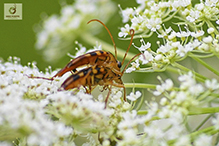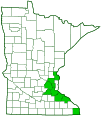yellow-horned flower longhorn beetle
(Strangalia luteicornis)
Conservation • Description • Habitat • Ecology • Distribution • Taxonomy
Conservation Status |
|
|||||||
| IUCN Red List | not listed |
|||||||
| NatureServe | NNR - Unranked |
|||||||
| Minnesota | not listed |
|||||||
Description |
||
Yellow-horned flower longhorn beetle is a medium-sized, early season beetle. It occurs in the United States east of the Great Plains and in southern Ontario Canada. In Minnesota it occurs in the southeast quarter of the state, where it is at the northwest extent of its range, and is absent from the remainder of the state. Larvae feed on the dead and decaying wood of various shrubs and hardwood trees, including viburnum, grape, beech, and elm. Adults are found from May to July on flowers in deciduous forests and edges. They feed on the nectar and possibly also pollen of a variety of flowers, especially sumac. Adults are ⅜″ to 9⁄16″ (9.0 to 14.0 mm) in length, elongate, slender, cylindrical, and strongly tapered to the rear. They are yellow or brownish-yellow with black markings. Males are slightly smaller and more slender than females. The head is angled forward in front and is abruptly constricted in back forming a neck that is visible when viewed from above. It is mostly yellow except for a pair of black spots on top of the head, a black spot on each side of the head in front of each compound eye, and some black mouth parts. The compound eyes are large, black, and deeply notched. The antennae are thread-like, slender, entirely yellow, and long, at least half as long as the body. The base of each antenna is inserted in the notch in the compound eye. All segments are uniformly slender. The third segment is much longer than the first (scape), the fourth is shorter than the third, and the fifth is longer than the fourth. The neck is yellow and has two black longitudinal stripes. The upper thoracic shield (pronotum) is bell-shaped and sinuate, narrow at the front, widening to the middle, narrowing slightly just beyond the middle, then widening to the base. It is as wide at the base as the base of the hardened wing covers (elytra). It is slightly inflated on top. The angles at the rear corners of the pronotum are very sharp and point outward. The pronotum is yellow with a pair of black longitudinal stripes in the middle, and a small black spot on each side near the middle of each line. The spot may be small and indistinct or large and connected to the stripe. The elytra are long and narrow, about 3 times as long as wide, and yellow with black markings. They taper evenly from the broad base to the narrow tip, making the body appear broad-shouldered. There are three pairs of large black spots that extend to the outer margin and often coalesce at the inner margin creating a bar across both elytra. The front margin has a broad black border, the inner margin (suture) has a narrow black border, and the outer margin sometimes has a narrow black border. The legs are slender and mostly yellow. The fourth segment (tibia) of each leg has a spur at the tip. On both sexes the third segment (femur) of the hind leg is black at the tip. The last part of each leg (tarsus), corresponding to the foot, has five segments but the fourth segment is minute and is concealed within the lobes of the heart-shaped third segment, making it appear that there are only four segments. On the hind leg, the tarsi are slender. The first segment is as long as all of the remaining segments together. The third segment is split beyond the middle. |
||
Size |
||
⅜″ to 9⁄16″ (9.0 to 14.0 mm) |
||
Similar Species |
||
Habitat |
||
Deciduous forests |
||
Ecology |
||
Season |
||
May to July |
||
Behavior |
||
|
||
Life Cycle |
||
|
||
Larva Food |
||
Dead and decaying wood of various shrubs and hardwood trees, including viburnum, grape, beech, and elm. |
||
Adult Food |
||
Flower nectar and possibly also pollen of a variety of flowers, especially sumac. |
||
Distribution |
||||
|
Sources |
|||
| 8/19/2022 | ||||
Occurrence |
||||
|
||||
Taxonomy |
|||
Order |
Coleoptera (Beetles) | ||
Suborder |
Polyphaga (Water, Rove, Scarab, Long-horned, Leaf, and Snout Beetles) | ||
Infraorder |
Cucujiformia | ||
Superfamily |
Chrysomeloidea (leaf beetles and allies) | ||
Family |
Cerambycidae (longhorn beetles) | ||
Subfamily |
Lepturinae (flower longhorn beetles) | ||
Tribe |
Lepturini | ||
Genus |
Strangalia | ||
Synonyms |
|||
Strangalia carolinae Strangalia eversa |
|||
Common Names |
|||
pale-horned long-horned beetle yellow-horned flower longhorn beetle |
|||
Glossary
Elytra
The hardened or leathery forewings of beetles used to protect the fragile hindwings, which are used for flying. Singular: elytron.
Femur
On insects and arachnids, the third, largest, most robust segment of the leg, coming immediately before the tibia. On humans, the thigh bone.
Pronotum
The exoskeletal plate on the upper side of the first segment of the thorax of an insect.
Scape
In plants: An erect, leafless stalk growing from the rootstock and supporting a flower or a flower cluster. In insects: The basal segment of the antenna.
Tarsus
On insects, the last two to five subdivisions of the leg, attached to the tibia; the foot. On spiders, the last segment of the leg. Plural: tarsi.
Tibia
The fourth segment of an insect leg, after the femur and before the tarsus (foot). The fifth segment of a spider leg or palp. Plural: tibiae.
Visitor Photos |
|||||
Share your photo of this insect. |
|||||
| This button not working for you? Simply email us at info@MinnesotaSeasons.com. Attach one or more photos and, if you like, a caption. |
|||||
Mike Poeppe |
|||||
 |
|||||
MinnesotaSeasons.com Photos |
|||||
|
|||||

Slideshows |
||

Visitor Videos |
|||
Share your video of this insect. |
|||
| This button not working for you? Simply email us at info@MinnesotaSeasons.com. Attach a video, a YouTube link, or a cloud storage link. |
|||
Other Videos |
|||
| Flower longhorn beetles on pasture rose, Wyandot County, Ohio USA Robert Klips |
|||
About
Jun 26, 2009 Two species of flower longhorn beetles (Coleoptera; Cerambicidae) occur on a pasture rose (Rosa carolina) flower in Wyandot County, Ohio. The larger one is Typocerus velutinus; the smaller is Strangalia luteicornis. |
|||

Created: 8/19/2022
Last Updated:


